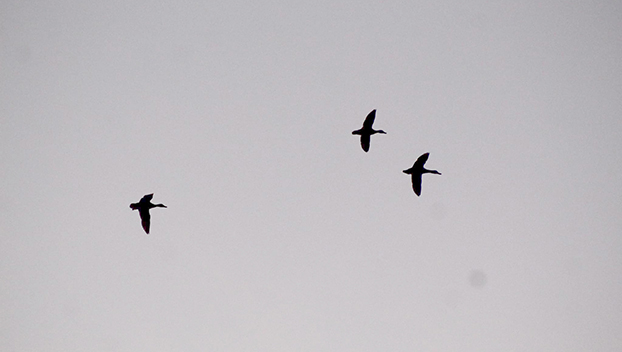Study shows duck ranges did shift
Published 3:00 pm Wednesday, June 12, 2024

- Three ducks fly over St. Catherine Creek National Wildlife Refuge south of Natchez. (File Photo | Hunter Cloud)
Over 60 years of data on winter ranges for pintail, mallards and blue winged teal showed there was indeed a shift in winter ranges. Research authored by scientists from the US Geological Survey, Ducks Unlimited and the US Fish and Wildlife Service worked to answer key questions in the waterfowl world.
According to the USGS, the study used 60 years of band recovery data in the Central and Mississippi Flyways of North America to determine shifts in the ranges of the three commonly banded and harvested dabbling duck species in the Mississippi and Central flyways.
Blue winged teal ranges shifted westward and southward in the winter while Mallard and Northern Pintail shifted eastward and northwards by anywhere from 60 to several hundred miles. Lisa Webb is the Southern Regional Supervisor for the USGS Cooperative Research Unites Program and a co-author of the study. She said public interest in waterfowl habits was one reason the study was carried out.
Trending
“This research was in direct response to public concern that duck winter ranges had shifted northward,” Webb said. “It was made possible by over half a century of work and investment by numerous waterfowl banders and supporting agencies in the United States and Canada.”
According to the paper, the band recoveries for blue winged teal from 1960 to 2019 was 13,768, mallard band recoveries from 1960 to 2019 were 325,512 and northern pintail from 1960 to 2019 were 15,674.
Species shifts
Specifically, blue winged teal banded in the prairie pothole region or northern great plains region moved south east by about 302 miles. Pintails banded in prairie habitat and western boreal area regions moved north by 219 miles and used 1.8 times more area compared to the 1960s according to the USGS.
Mallards had northwards shifts in January locations by 217 miles in all three sub populations. While teal and pintails appear to have home ranges incorporating most of Mississippi, on the map, it appears the ranges of mallards stop along the I-20 corridor.
“While the winter ranges of mallards and northern pintail did, indeed, shift northward during the months of December and January, the scale of the shifts were small compared to the overall geographic distribution of these species during those months,” USGS stated in a press release. “Furthermore, there was no evidence of complete abandonment of large wintering regions. The authors caution that summarizing shifts across species, months or subpopulations may hide finer-scale patterns that would be important to habitat conservation and population management.”
Trending
Statistical genius
To determine shifts in duck species ranges, the authors created duck distribution maps with locations from 350,000 or more banded ducks recovered during the fall and winter months. These were then compared to overlap of duck distributions for the three species from the 1960s and the present day. A lot of statistical analysis, plotting and equations went into the project as described in the team’s research paper.
Community science through band reporting made a difference in the project. Lead author of the study Bram Verheijen said “We are grateful to the thousands of waterfowl hunters that enabled this study by reporting waterfowl band recoveries.”
Follow up studies
The purpose of the study was to determine if, where and how much the ducks’ ranges had shifted. Follow-up research will look to answer why the shifts have occurred and is already underway.
USFWS Wildlife Biologist and study co-author Heath Hagy said there could be a wide variety of factors behind the shifts in ranges.
“Loss and degradation of breeding habitat, changing land use, climate change and ever evolving agricultural practices are likely all affecting migration patterns of ducks and geese,” Hagy siad. “The causes of the changes are complex, vary by species and manifest themselves differently across breeding areas such that no single factor can be blamed directly for the changes.”





